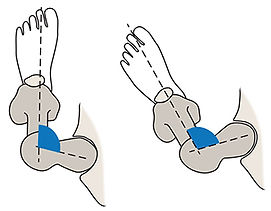Hip Disorders
Excessive Version
The development of the hip plays a critical role in the health of the joint. Excessive version, either anteversion (inward) or retroversion (outward), can be treated non-operatively unless the condition creates significant functional or cosmetic difficulties.

Anteversion
Extreme Femoral Anteversion

Notice that the angle describing the position between the femoral neck and foot (in blue) is smaller than normal. Most patients "in-toe" to make the femoral head more comfortable.
Anteversion is the rotation of an organ towards the front of the body. In the hip joint it can be seen in the acetabulum or femur, or both at the same time. The human hip is normally anteverted. Only when this is excessive is it problematic. Excessive acetabular anteversion, commonly associated with hypoplasia (or underdevelopment) of the front of the hip socket, is frequently seen in developmental dysplasia of the hip (DDH). During a periacetabular osteotomy (PAO), the socket can be rotated to correct this.
Excessive anteversion can accrue from angulation forward or rotation forward or a combination. It is often associated with excessive internal rotation of the hip joint motion. "In-toeing" or "pigeon-toeing" is often noted by mothers whose child has excessive internal rotation and this is usually associated with diminished external rotation. Many cases of anteversion in children are painless and correct themselves over time.
There are some exceptions when the femoral rotation is not corrected naturally and the condition persists into adulthood. In these cases surgery is not required unless the anteversion is extreme enough to create difficulties with everyday tasks such as walking.
When surgery is required, the operation of choice is an intertrochanteric osteotomy (ITO). This allows the malrotation of the femur to be corrected, and can be done in combination with a PAO.
Retroversion
Extreme Femoral Retroversion

The angle between the femoral neck and foot (in blue) is larger than normal causing most patients to "out-toe"
In the hip joint, retroversion can occur in the acetabulum or femur. On the acetabular side, it is associated with excessive prominence of the anterior wall of the socket on x-ray and restricts flexion of the hip. When significant enough, it can be corrected by performing an anteverting PAO. In mild cases, arthroscopic trimming of the anterior wall can be effective.
On the femoral side, there is usually excessive external rotation, commonly referred to as "out-toe" or "duck-foot" walking. It can be due to posterior angulation or rotation. Femoral retroversion is a risk factor for impingement against the anterior acetabulum. When significant, intertrochanteric osteotomies (ITO) can correct the malrotation and redirect the femoral head more anterior.
